Riverside Drive (Manhattan)
Riverside Drive is a scenic north–south thoroughfare in the New York City borough of Manhattan. The road runs on the Upper West Side of Manhattan, generally paralleling the Hudson River and Riverside Park between 72nd Street and the vicinity of the George Washington Bridge at 181st Street. North of 96th Street, Riverside Drive is a wide divided boulevard. At several locations, a serpentine local street diverges from the main road, providing access to the residential buildings. Some of the city's most coveted addresses are located along its route.
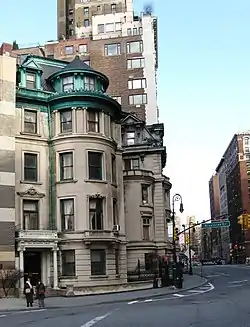 1 Riverside Drive at 72nd Street, (C.P.H. Gilbert, architect. Now a satellite location for the Islamic Cultural Center of New York) | |
| Owner | City of New York |
|---|---|
| Maintained by | NYCDOT |
| Location | Manhattan, New York City |
| South end | 72nd Street in Upper West Side |
| North end | 181st Street in Washington Heights Dyckman Street in Inwood (disconnected segment) |
| East | West End Avenue (72nd–107th Sts) Broadway (107th–116th, 127–159th Sts) Claremont Avenue (116th–127th Sts (Tiemann Pl)) Fort Washington Avenue (159th–168th Sts) Haven Avenue (168th–181st Sts) |
| West | Henry Hudson Parkway |
| Construction | |
| Commissioned | March 1811 |
| Completion | 1910[1] |
History
Development
The 191 acres (0.77 km2) of land in the original park between 72nd to 125th Streets were originally inhabited by the Lenape people, but by the 18th century were used for farms by the descendants of European colonists.[2]: 68 In 1846, the Hudson River Railroad (later the West Side Line and Hudson Line) was built along the waterfront, connecting New York City to Albany.[3]: 3 [4] In 1865, Central Park commissioner William R. Martin put forth the first proposal for a riverside park along the Hudson River.[3]: 3 [4][5] An act providing for such was presented to the Legislature by commissioner Andrew Haswell Green in 1866 and approved the same year.[6]: 9 The first segment of Riverside Park was acquired through condemnation in 1872.[1] The park also included the construction of Riverside Drive (then known as Riverside Avenue), a tree-lined drive curving around the valleys and rock outcroppings, overlooking the future park and the waterfront. The avenue was laid out in 1868 and was 100 feet (30 m) wide for its entire length.[6]: 9 [7] The plans for Riverside Park and Avenue brought the attention of William M. Tweed, who bought several lots adjacent to the park in anticipation of its construction.[6]: 9
A selection process for the designers of Riverside Park followed, and in 1873 the commissioners selected Frederick Law Olmsted, a park commissioner who had also designed Central Park.[3]: 4 [4] Initially, Riverside Avenue had been planned to run in a straight line, which would have required a retaining wall and extensive fill.[2]: 69 By then, the difficult topography of the area had come to the attention of the Manhattan park commissioners, and in 1873 Olmsted was given the authorization to redesign the grade of Riverside Avenue. To accommodate this, Olmsted devised a new plan that would create a main road extending from 72nd to 123rd Streets, with overpasses at 79th and 96th Streets, as well as "carriage roads" to serve the nearby neighborhood. The grade of the road was not to exceed 1:27.[2]: 71 [6]: 10 [7] Riverside Avenue's main road would contain two roadways, one for each direction, separated by a median. A pedestrian path and a horse path would run alongside the avenue, and trees would provide shade along the route.[2]: 71
Over the following years, work proceeded on Riverside Avenue, with various ramps and stairs to the park as well as a bridle path between 104th and 120th Streets. In 1876 Olmsted was asked to create plans for the design of the avenue as a country drive, but ultimately it was paved. In late 1876, bids were accepted for the paving of Riverside Avenue.[6]: 10 Olmsted was ousted as parks superintendent in December 1877.[8] From 1875 to 1910, architects and horticulturalists such as Calvert Vaux and Samuel Parsons laid out the stretch of park/road between 72nd and 125th Streets according to the English gardening ideal, creating the appearance that the park was an extension of the Hudson River Valley.[1]
The avenue was opened in 1880 and was well used by pedestrians, bikers, and drivers;[6]: 11 it had cost nearly $10 million.[9] By the end of the 19th century, nearly every lot on the eastern side of Riverside Drive had been developed with private mansions and apartment buildings. By comparison, there had been fewer than 10 houses between 72nd and 125th Streets on the shoreline before construction of the avenue began.[9]
Late 19th and early 20th centuries
Riverside Drive's original northern terminus was at Grant's Tomb near 122nd Street.[9][10] In January 1897, state lawmakers proposed extending Riverside Drive northward to the Boulevard Lafayette near 157th Street, with a viaduct above Manhattan Valley from 122nd to 134th Street.[11][12] The original plans, which were to cost $10 million and included four viaducts, were quickly downsized to $2 million and one viaduct.[13] Shortly afterward, a similar bill with a reduced budget was proposed in the state legislature.[14] The revised bill called for the avenue to be narrowed in the vicinity of Trinity Cemetery at 153rd Street.[14][15] The governor of New York signed both bills in May 1897,[16][17] but work on the viaduct was delayed for several months.[18] That November, the city's Board of Street Opening and Improvement agreed to lengthen the viaduct slightly so that it ran from 122nd to 135th Street. The extension was budgeted at $3.6 million, with the viaduct alone costing $840,000.[19][20] At 153rd Street, Riverside Drive would be cantilevered over the West Side Line railroad tracks to avoid Trinity Church Cemetery.[10] The extension plans also involved demolishing several old mansions.[21]
96th Street overpass and Manhattan Valley Viaduct
The New York City Board of Estimate formally approved the Manhattan Valley Viaduct in December 1898,[22][23] and plans for the viaduct were drawn up within three weeks.[24] At the end of the month, the firm of O'Brien, Sheehan, and McBean was hired to build the viaduct for $570,000;[25][26] under the terms of the contract, the viaduct had to be completed in 400 days.[27] Work on the viaduct began in March 1898.[28] The viaduct's engineers requested in June 1898 that the approaches be made of granite rather than sandstone, which would add $80,000 to the cost;[29] the city's comptroller opposed the change.[30] The next month, the city authorized $86,500 in bonds to finance an overpass above 96th Street[31] and $500,000 in bonds for the Manhattan Valley Viaduct.[32][33]
The city's park commissioners began soliciting bids for the 96th Street overpass in June 1900[34] and awarded a contract the next month to A. C. Gildersleeve for $200,000.[35] Work on the 96th Street overpass began later the same year.[36] Meanwhile, the abutments for the Manhattan Valley Viaduct were finished by mid-1900.[37][38] The chief engineer of the city's highways departments reported in April 1901 that the Manhattan Valley Viaduct was completed except for filling and electrical work.[39] Work on the 96th Street overpass was delayed for two months due to difficulties in installing sewage pipes;[40] the overpass opened in January 1902[41][42] following complaints that the contractor was taking too long.[43] The Manhattan Valley Viaduct was completed in mid-1902.[9] The construction of the 96th Street overpass and Manhattan Valley Viaduct caused real-estate prices along Riverside Drive to increase in the 1900s.[44] Arc lamps were installed on the Manhattan Valley Viaduct in 1903, soon after it opened.[45]
Extension to 155th Street
The city's corporation council began condemning land for the extension of Riverside Drive north of the Manhattan Valley Viaduct in mid-1899,[46] and three commissioners were appointed to condemn the land the next year.[47] The city acquired the land in September 1900.[48] Most of the condemned sites had been small plots, except for a tract between 142nd and 144th Streets that had belonged to the Hoguet family.[9] The project was split into two phases, section 1 between 135th and 153rd Streets, and section 2 between 153rd Street and the Boulevard Lafayette. By August 1901, plans for section 1 had been completed, with that section estimated to cost $1.7 million.[49][50] The extension would consist of a 60-foot-wide (18 m) roadway, a 20-foot-wide (6.1 m) carriage path, two sidewalks, and grass planting strips. There were also to be four bridges carrying the avenue between 135th and 156th Streets.[51][52] Along with the Boulevard Lafayette (which extended north of Broadway and 156th Street[53]), the Riverside Drive extension would form part of a 20-mile (32 km) parkway that would connect with Harlem River Drive.[39][54] Construction did not start for over two years after the city acquired land for the Riverside Drive extension.[48] In the meantime, dirt from the excavation of the city's first subway line was dumped on the path of the extension.[55]
A state judge ruled in April 1903 that construction of the Riverside Drive extension had to start as soon as possible,[56] and a groundbreaking ceremony for the extension occurred on December 12, 1903.[57][58] The section from 135th to 145th Street was awarded to Ryan & Parker, while the section from 145th to 155th Street was awarded to John C. Rodgers; work on both sections began in May 1904.[9] The section of Riverside Drive north of 150th Street was much higher than the streets that it intersected, prompting residents of these cross-streets to complain that their vehicles could not access Riverside Drive.[59] The plans also included widening the Boulevard Lafayette within the Washington Heights neighborhood and constructing a service road to the east of the existing boulevard. Because people frequently referred to the Boulevard Lafayette by several incorrect names, residents of Washington Heights also wanted the Boulevard Lafayette to be renamed Riverside Drive.[9]
The city planned to acquire land to widen the section of the Boulevard Lafayette (then renamed Riverside Drive) between 158th and 165th Streets in 1907, but the city's controller objected to the $1 million valuation placed on the land.[60][61] By mid-1908, Riverside Drive was complete to 155th Street, except for a single city block between 151st and 152nd Streets, where a property owner had successfully requested that a state judge place an injunction on the project.[62] A few blocks north, families with plots in Trinity Church Cemetery complained that the new road was obstructing views of the Hudson River from their plots.[63]
Late 1900s to 1920s
As early as 1906, engineers considered extending Riverside Drive further north from 158th Street to the proposed Henry Hudson Bridge.[64] In 1908, the Board of Estimate declined to provide an appropriation for the further extension of Riverside Drive, saying the city did not have enough money.[65] That year, the entire avenue was renamed Riverside Drive.[6]: 10 Olmsted and Arnold W. Brunner recommended in 1913 that Riverside Drive be extended north to the Bronx, with a new viaduct connecting 155th Street and the Boulevard Lafayette.[66]
Around 122nd Street, the avenue split into two roadways, one each to the west and east of Grant's Tomb; both roadways originally carried two-way traffic. After a pedestrian was killed in 1915, the roadway to the west of the tomb was converted to carry one-way southbound traffic, while the roadway to the east was converted to carry one-way northbound traffic.[67]
In late 1926, the Municipal Art Commission approved the construction of a viaduct carrying Riverside Drive West between 155th and 161st Street in Hamilton Heights.[68][69] At the time, traffic was forced to divert onto narrow local roads to continue along Riverside Drive in either direction.[70] Workers began constructing foundations for the viaduct the same year.[71] The P. T. Cox Construction Co. was hired in April 1927 to provide 5,000 short tons (4,500 long tons; 4,500 t) of structural steel for the viaduct.[72] Later that year, a state judge determined that it would cost $3.3 million to acquire land for a northward extension of Riverside Drive.[73] The viaduct was opened on November 28, 1928; it had cost $2.36 million.[74][75] There were also plans to repave the Manhattan Valley Viaduct, which had been built with a wooden-block roadbed that was starting to deteriorate.[76]
Riverside Park expansion and late 20th century

In the 1930s, New York Central Railroad's rail track north of 72nd Street was covered in a Robert Moses project called the West Side Improvement.[77] Moses' biographer Robert Caro described Moses surveying the area prior to his project, and seeing:
a wasteland six miles (10 km) long, stretching from where he stood all the way north to 181st street.... The 'park' was nothing but a vast low-lying mass of dirt and mud.... Unpainted, rusting, jagged wire fences along the tracks barred the city from its waterfront...The engines that pulled trains along the tracks burned coal or oil; from their smokestacks, a dense black smog rose toward the apartment houses, coating windowsills with grit.... [a stench] seemed to hang over Riverside Drive endlessly after each passage of a train carrying south to the slaughterhouses in downtown Manhattan carload after carload of cattle and pigs.... [Once, Frances Perkins ] heard Moses exclaim, "Isn't this a temptation to you? Couldn't this waterfront be the most beautiful thing in the world?"[78]
The Moses project, which was bigger than the Hoover Dam project, created the Henry Hudson Parkway, buried the West Side Line in the Freedom Tunnel, and greatly expanded Riverside Park.[79] In addition, in the mid-1930s, city officials extended Riverside Drive northward to the Henry Hudson Bridge; this extension became part of Henry Hudson Parkway.[80]
The Manhattan Valley Viaduct in Manhattanville underwent a two-year-long reconstruction in 1961. Another renovation project for the viaduct was scheduled in 1981, at which point the project was to cost $27 million. Work started in 1985, after the deck had corroded significantly, prompting officials to spend another $9.5 million replacing girders.[81]
Riverside South
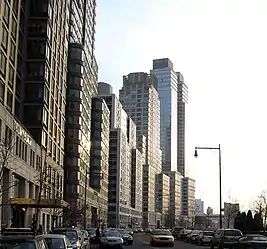
In the 1980s Donald Trump, then owner of the 57 acres (230,000 m2) of land just south of Riverside Park that had been the Penn Central freight rail yard, proposed a very large real estate development project.[82] However, hampered by his weakened financial condition and opposed by six civic groups (Municipal Art Society, Natural Resources Defense Council, New Yorkers for Parks, Regional Plan Association, Riverside Park Fund, and Westpride), Trump agreed in 1990 to their plan, which was designed to mimic Riverside Park and Drive further north. Though scaled down, the project is still the second biggest private real estate venture under construction in New York City.[83][84]
The agreed-upon plan would expand Riverside Park by 23 acres (93,000 m2) and extend Riverside Drive to the south as Riverside Boulevard. The new Riverside Park South, stretching between 72nd and 59th streets, is the central element of the development. Portions of the former rail yard, such as the New York Central Railroad 69th Street Transfer Bridge, are incorporated into the new park.[85]
Route
Starting at 72nd Street, Riverside Drive passes through the Manhattan neighborhoods of the Upper West Side, Morningside Heights, over Manhattanville in West Harlem by way of the Riverside Drive Viaduct and through Washington Heights. Below 72nd Street, Riverside Drive continues as Riverside Boulevard which stretches through Riverside South to 59th Street where it merges into the West Side Highway.
Only a few stretches of Riverside Drive were built along an older road; due to the hilly terrain, Riverside Drive crosses a natural cleft in the bedrock at 87th Street on an iron viaduct and passes over 96th Street, Tiemann Place and 135th Street, and 158th Street on further viaducts. At Tiemann Place and 135th Street, and at 158th Street, an old alignment is present, also named Riverside Drive, while the viaduct portion or main route is officially named and signed "Riverside Drive West". The viaduct between Tiemann Place and 135th Street is called the Manhattan Valley Viaduct.
At its north end, Riverside Drive merges with the northbound lanes of the Henry Hudson Parkway; when the parkway was built, the Henry Hudson's northbound lanes used the roadway of Riverside Drive. In 2005, the retaining wall of Castle Village collapsed onto both Riverside Drive and the northbound lanes of the Henry Hudson Parkway.[86] The wall was repaired and the roadway reopened in March 2008.[87]
North of 158th Street the right of way which currently carries the name Riverside Drive was known as Boulevard Lafayette, which led to Plaza Lafayette in Hudson Heights. The section exiting the parkway at the Dyckman Street exit and ending at Broadway is still known as Riverside Drive.
The M5 New York City Bus route serves Riverside Drive from 72nd to 135th Streets, while the Bx6 and Bx6 SBS terminate at Riverside Drive and 158th Street.[88]
96th Street
A small bridge carries Riverside Drive over 96th Street. When this overpass was built, it was described as a viaduct with buttresses and stone terraces leading down to Riverside Park and the Hudson River. Semicircular shelters were also built next to the viaduct on either side of 96th Street.[89] Although the overpass is clad with stone, its superstructure is made of steel.[36]
Manhattan Valley Viaduct
Between Tiemann Place and 135th Street is a viaduct that carries Riverside Drive above 12th Avenue; built in 1901, it is variously called the 125th Street Viaduct, Riverside Drive Viaduct,[81] or Manhattan Valley Viaduct.[22] Francis Stuart Williamson was the chief engineer for the viaduct.[90] Despite the structure's utilitarian role as a highway, it was also a strong symbol of civic pride, inspired by America's late 19th-century City Beautiful movement. The viaduct's original roadway, wide pedestrian walks and overall design was highly ornamented.[90] The New-York Tribune described the viaduct in 1900 as "another attractive feature [on] the already impressively beautiful east bank of the Hudson River at Riverside Park and Washington Heights".[37]
As planned, the viaduct measured 1,564 feet (477 m) long, excluding the approaches. The viaduct carries a roadway measuring 60 feet (18 m) wide, as well as a 10-foot (3.0 m) wide sidewalk on either side of the viaduct.[28][90] The viaduct measures 95 feet (29 m) above mean high water at 125th Street and 75 feet (23 m) above mean high water at 135th Street.[28] It is divided into 26 bays, each comprising a single span. Twenty-two of the spans are 65 feet (20 m) long; one of the spans, crossing 125th Street, is 128 feet (39 m) long; and the three northernmost spans are of irregular length.[28] Each arch is composed of latticed plate girders measuring 3 feet (0.91 m) long.[90] Under the roadway are 60-foot-wide (18 m) transverse steel girders, which were built in several pieces and riveted together;[81] each girder is 5 feet (1.5 m) deep.[90] The main span above 125th Street is supported by two plate girders measuring 130 by 10 by 8 feet (39.6 by 3.0 by 2.4 m) across,[90] which were described as the world's largest steel girders at the time of the viaduct's completion.[90][91]
Including the approaches to the south and north, the viaduct has a total length of 2,044 feet (623 m)[22][28] or 2,074 feet (632 m).[90] The northern approach is 262 feet (80 m) long, while the southern approach is 218 feet (66 m) long.[28] The approaches are of rock-faced Mohawk Valley limestone with Maine granite trimmings, the face work being made up of courses of ashlar. The southern approach consists of a semicircular wall with stone staircases on either side.[90] This was intended to give a broad plaza effect, which was intended to impart deliberate grandeur to the natural terminus of much of Riverside Drive's traffic as well as to give full advantage to the vista overlooking the Hudson River and New Jersey Palisades to the west.[92][93] There is also a single masonry arch with a glazed-brick vault next to the southern approach.[37]
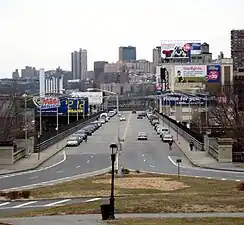 125th Street Viaduct
125th Street Viaduct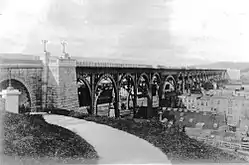 Under construction
Under construction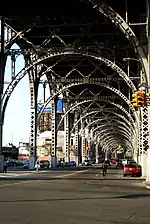 Below, facing north
Below, facing north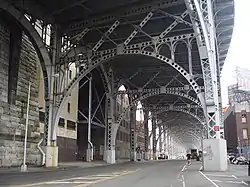 Below, facing south
Below, facing south
155th to 161st Street
Another viaduct carries Riverside Drive between 155th and 161st Streets. This viaduct is .25 miles (0.40 km) long and 60 feet (18 m) wide, carrying six lanes of traffic. The structure is made of steel and stone, and the arches under the roadway are infilled with granite or paneled concrete and are topped by metal-framed windows. The roadway itself has granite balustrades with ornamental lampposts.[70]
Buildings and monuments
Residential buildings
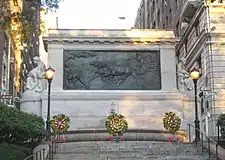
At the end of the 19th century, the eastern side of Riverside Drive was a series of luxuriously finished rowhouses interspersed with free-standing nineteenth century mansions set in large lawns.[94][95] Today, it is lined with apartment buildings such as the Normandy and the Master Apartments, as well as some remaining town houses from 72nd to 118th Streets.
The brick-faced Schwab House occupies the site of "Riverside", built for steel magnate Charles M. Schwab, formerly the grandest and most ambitious house ever built on Manhattan Island. Among the more eye-catching apartment houses are the curved facades of The Colosseum and The Paterno and the Cliff-Dwellers Apartments at 96th Street, with mountain lions and buffalo skulls on its friezes. The Henry Codman Potter house at 89th Street is one of the few remaining mansions on Riverside Drive; it houses Yeshiva Chofetz Chaim. The Master Apartments at 310 Riverside Drive, a landmarked[96] 24-story Art Deco skyscraper, is near Columbia University and the 370 Riverside Drive building, which was erected in 1922–23 for approximately $800,000 by Simon Schwartz and Arthur Gross.[97] International House is at 500 Riverside Drive, the next building north of Riverside Church, facing Grant's Tomb, with a back entrance on Claremont Avenue.
Other structures
The Nicholas Roerich Museum is on 107th Street and Riverside Drive. The Interchurch Center and Riverside Church are located at 120th Street and Riverside Drive, while Sakura Park is located two blocks north. Other attractions on Riverside Drive include Riverbank State Park, Trinity Church Cemetery, Columbia-Presbyterian Medical Center, and Fort Washington Park.
Among the monuments along its route are the Eleanor Roosevelt Monument at 72nd Street,[98] the Soldiers' and Sailors' Monument at 89th Street,[99] Anna Hyatt Huntington's Joan of Arc at 93rd Street,[100] a monument to John Merven Carrère by Thomas Hastings at 99th Street,[101] Attilio Piccirilli's Fireman's Memorial at 100th Street,[102] and the Amiable Child Monument and Grant's Tomb at 122nd Street.[94]
Notable residents
- Marian Anderson (1897–1993), contralto and one of the most celebrated singers of the twentieth century; lived at 730 Riverside Drive.[103][104]
- Hannah Arendt (1906–1975), political theorist, lived at 370 Riverside Drive from 1959 until her death in 1975.
- Saul Bellow (1915–2005), author, lived at 333 Riverside Drive in the 1950s[105]
- Rafael Díez de la Cortina y Olaeta (1859–1939), linguist, resident of 431 Riverside Drive[106]
- Ralph Ellison (1913–1994), writer, longtime resident of 730 Riverside Drive.[104]
- Alfred T. Fellheimer (1875–1959), lead architect for Grand Central Terminal and Cincinnati Union Terminal; lived at 730 Riverside Drive.[103]
- George Gershwin (1898–1937), composer and pianist; occupied a penthouse at 33 Riverside Drive.[107]
- Ira Gershwin (1896–1983), lyricist; occupied a penthouse at 33 Riverside Drive, adjoining his brother's apartment.[107]
- Katie Halper, American comedian, writer, journalist, filmmaker, podcaster, political commentator, and teacher.[108]
- William Randolph Hearst (1863–1951), newspaper publisher; owned a five-story penthouse in the Clarendon at 137 Riverside Drive[109]
- John and Faith Hubley lived together and operated their Academy Award-winning independent animation studio from their apartment at 110 Riverside Drive.[110]
- Jacob K. Javits (1904–1986), United States Senator from New York from 1957 to 1981; lived at 730 Riverside Drive.[103][104]
- Uwe Johnson, German author[111]
- Paul Krugman, Nobel Prize in economics winner[112]
- J. Robert Oppenheimer and his family lived at 155 Riverside Drive on 88th Street.[113]
- Sergei Rachmaninoff owned a townhouse at 33 Riverside Drive, the predecessor to the present apartment block.[114]
- Bolesław Wieniawa-Długoszowski, Polish general, adjutant to Chief of State Józef Piłsudski, politician, diplomat and formally for one day the President of the Republic of Poland lived at 3 Riverside Drive.[115]
- Grantland Rice, American sportswriter[116]
- Jim Rogers, investor and financial commentator[117]
- Damon Runyon, American newspaper man and author[116]
- Babe Ruth, lived at 173 Riverside Drive, then 110 Riverside Drive[118]
- Thomas Sowell, American economist and social theorist, lived on the ground floor of a building on 152nd Street and Riverside Drive in the early 1950s[119]
In popular culture
- The part of the drive over the 125th Street Viaduct has been seen in the movie The Amazing Spider-Man (2012).[120]
- Scenes from Woody Allen's Manhattan (1979) were filmed at 265 Riverside Drive.[121]
- She'll Drive the Big Car on David Bowie's Reality (2003) album features a woman driving along Riverside Drive.[122]
Gallery
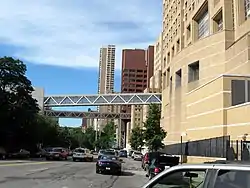 Near 165th Street
Near 165th Street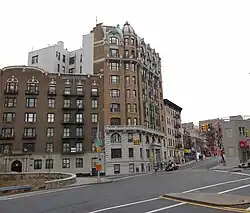 At 158th Street
At 158th Street At 145th Street
At 145th Street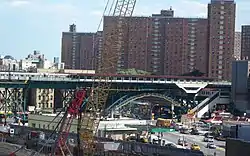 The 125th Street station on the IRT Seventh Avenue Line, seen from Riverside Drive's upper level
The 125th Street station on the IRT Seventh Avenue Line, seen from Riverside Drive's upper level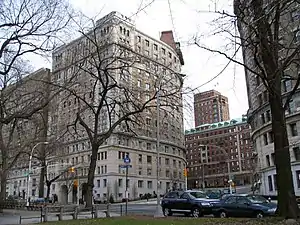 Curved facades of The Colosseum and The Paterno at 116th Street
Curved facades of The Colosseum and The Paterno at 116th Street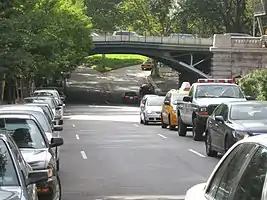 At 96th Street, which passes under Riverside Drive
At 96th Street, which passes under Riverside Drive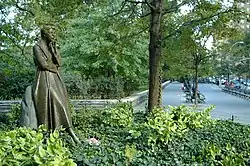 Riverside Drive's southern end at 72nd Street, looking north from the Eleanor Roosevelt Memorial Plaza
Riverside Drive's southern end at 72nd Street, looking north from the Eleanor Roosevelt Memorial Plaza
References
Notes
- Park history, riversideparknyc.org. Retrieved August 26, 2014.
- "Riverside Park Master Plan October 2017". New York City Department of Parks and Recreation. November 2, 2017. Retrieved August 19, 2019 – via Issuu.
- Grimm, E.; Schroeder, E.P. (2007). Riverside Park: The Splendid Sliver. Columbia University Press. ISBN 978-0-231-51219-0.
- "Riverside Park Highlights : NYC Parks". New York City Department of Parks & Recreation. June 26, 1939. Retrieved August 20, 2019.
- "Board of Commissioners of the Central Park – Documents: May 11, 1865 – January 11, 1866" (PDF). nyc.gov. New York City Department of Parks and Recreation. 1866. pp. 3–5. Retrieved July 30, 2019.
- "Riverside Park and Riverside Drive" (PDF). New York City Landmarks Preservation Commission. February 9, 1980. Retrieved July 28, 2019.
- "Board of Commissioners of the NYC Dept of Public Parks – Documents: January 20, 1874 – April 30, 1875" (PDF). nyc.gov. New York City Department of Parks and Recreation. 1875. pp. 2–8. Retrieved July 30, 2019.
- Rosenzweig, Roy & Blackmar, Elizabeth (1992). The Park and the People: A History of Central Park. Cornell University Press. pp. 291–293. ISBN 0-8014-9751-5.
- "New York's Long Fight for the New Riverside Drive; To Be the Finest Thing of the Kind Within the Limits of Any City in the World". The New York Times. July 10, 1904. Retrieved August 17, 2023.
- "Riverside Drive Extension". New-York Tribune. December 5, 1897. p. 20. Retrieved August 17, 2023.
- "New Driveway Planned; Extension of Riverside to the Boulevard Lafayette. To Cross the Manhattan Valley on a Viaduct, and Form a Continuour Pleasure Drive as far as Inwood". The New York Times. January 28, 2023. ISSN 0362-4331. Retrieved August 16, 2023.
- "To Extend Riverside Drive: an Attractive Uptown Scheme of Improvement Need of a Connecting Link Between Claremont and the Boulevard ... A Delightful Residence Region May Be Opened". New-York Tribune. January 25, 1897. p. 10. ISSN 1941-0646. ProQuest 574263375. Retrieved August 16, 2023.
- "New Riverside Drive Bill". New-York Tribune. January 29, 1897. p. 2. Retrieved August 16, 2023.
- "Riverside Drive Plans: Why a Second Bill for the Extension Was Prepared a Connection With the Boulevard Lafayette of the Greatest Importance-the First Plan Deemed Too Comprehensive and Costly". New-York Tribune. February 6, 1897. p. 7. ISSN 1941-0646. ProQuest 574271354.
- "To Honor Queen Victoria; Stained Glass Window for the Church of St. John the Evangelist". The New York Times. January 28, 2023. ISSN 0362-4331. Retrieved August 16, 2023.
- "Many City Bills Signed: Among Them Those Relating to Riverside Drive and Riverside Park". New-York Tribune. May 24, 1897. p. 3. ISSN 1941-0646. ProQuest 574306547.
- "Brooklyn Bridge Bill Signed". The Sun. May 23, 1897. p. 4. Retrieved August 16, 2023.
- "City Suffers by Careless Work". The World. December 28, 1897. p. 5. Retrieved August 16, 2023.
- "Riverside Drive Plans: the Board of Street Opening Decides to Lengthen It to One-hundred-and-thirty-fifth-st". New-York Tribune. November 18, 1897. p. 3. ISSN 1941-0646. ProQuest 574367296.
- "Riverside Drive Viaduct; Partial Plan for the Proposed Extension Above Grant's Tomb Adopted". The New York Times. January 28, 2023. ISSN 0362-4331. Retrieved August 16, 2023.
- "Old Estates That Must Go: Ravages to Result From the Riverside Drive Extension". New-York Tribune. August 15, 1897. p. B4. ISSN 1941-0646. ProQuest 574337313.
- "Manhattan Valley Viaduct". The Sun. December 8, 1897. p. 1. Retrieved August 17, 2023.
- "Board of Estimate Grants; Further Progress Made with the City Budget – Riverside Drive Extension Plans Approved". The New York Times. January 28, 2023. ISSN 0362-4331. Retrieved August 17, 2023.
- "Viaduct Plans Were Rushed". The World. December 27, 1897. pp. 1, 2. Retrieved August 17, 2023.
- "Secured by Sheehan's Firm". The Buffalo Commercial. December 29, 1897. p. 1. Retrieved August 17, 2023.
- "Inspection of Barbers' Shops; Workmen Have a Bill to Present to the Legislature". The New York Times. January 28, 2023. ISSN 0362-4331. Retrieved August 17, 2023.
- "Bridges". The Construction News. Vol. 6, no. 1. January 5, 1898. p. 17. ProQuest 128388973.
- "The Riverside Viaduct: Work Far Advanced on the Extension of the Drive to Lafayette Boulevard". New-York Tribune. October 15, 1899. p. C3. ISSN 1941-0646. ProQuest 574674810.
- "The Riverside Drive Extension". New-York Tribune. June 17, 1898. p. 6. ISSN 1941-0646. ProQuest 574457720.
- "Van Wyck Waxes Eloquent". Times Union. July 12, 1898. p. 5. Retrieved August 17, 2023.
- "The Board of Estimate; Debt Limit Scare Ended by Reauthorization of Bonds for Public Improvements". The New York Times. June 8, 1898. ISSN 0362-4331. Retrieved January 28, 2023.
- "The Big Bond Issue". The Standard Union. July 27, 1898. p. 8. Retrieved August 17, 2023.
- "Issue of City Bonds". The New York Times. July 28, 1898. p. 12. ISSN 0362-4331. Retrieved August 17, 2023.
- "Riverside Viaduct". The Brooklyn Daily Eagle. June 22, 1900. p. 5. Retrieved August 17, 2023.
- "Park Board Awards a Contract". New-York Tribune. July 20, 1900. p. 11. Retrieved August 17, 2023.
- "The Viaduct at Ninety-sixth-st". New-York Tribune. March 3, 1901. p. 19. Retrieved August 17, 2023.
- "Riverside Viaduct: Addition Which It Makes to the Beauty and Splendor of the Park". New-York Tribune. September 9, 1900. p. A3. ISSN 1941-0646. ProQuest 570835018. Retrieved August 17, 2023.
- "Giant Superstructure". Poughkeepsie Eagle-News. July 5, 1900. p. 7. Retrieved August 17, 2023.
- "A New Driveway Planned". New-York Tribune. April 21, 1901. p. 5. Retrieved August 17, 2023.
- "Sewer Department Blamed for Delay: Riverside Drive Viaduct Contractor Says He Had to Buy Out Others". New-York Tribune. November 19, 1901. p. 7. ISSN 1941-0646. ProQuest 571115650. Retrieved August 17, 2023.
- "Open This Week". The Brooklyn Daily Eagle. January 14, 1902. p. 2. Retrieved August 17, 2023.
- "Viaduct to Be Opened This Week". New-York Tribune. January 15, 1902. p. 7. Retrieved August 17, 2023.
- "Riverside Drive Wakes Up". The Sun. February 23, 1902. p. 21. Retrieved August 17, 2023.
- "Building in Riverside Drive: Many Handsome Houses Going Up-opening of New Bridges Promises Increased Activity". New-York Tribune. October 6, 1901. p. 12. ISSN 1941-0646. ProQuest 571097489.
- "Orders Arc Lamps on Claremont Viaduct". The Evening World. October 8, 1903. p. 3. Retrieved August 17, 2023.
- "To Extend Riverside Drive: Commissioners to Condemn Right of Way Soon to Be Appointed". New-York Tribune. May 11, 1899. p. 3. ISSN 1941-0646. ProQuest 574611050.
- "Riverside Drive Commissioners". The New York Times. March 14, 1900. ISSN 0362-4331. Retrieved August 17, 2023.
- "President Cantor Criticised in Court; Application for Peremptory Mandamus to Compel Extension of Riverside Drive – Property Owners' Complaints". The New York Times. March 10, 1903. Retrieved August 17, 2023.
- "City's Finest Parkway". The New York Times. August 8, 1901. p. 12. Retrieved August 17, 2023.
- "Riverside Drive Extension". The Brooklyn Citizen. August 8, 1901. p. 8. Retrieved August 17, 2023.
- "Along the Hudson: to Extend Riverside Plans for Connection With the Boulevard Lafayette". New-York Tribune. December 14, 1902. p. A9. ISSN 1941-0646. ProQuest 571337614.
- "Plans Ready for New Driveway; President Cantor's Project for Seven-Mile Stretch Along the Hudson River – Riverside Drive to be Connected With the Boulevard Lafayette". The New York Times. December 14, 1902. Retrieved August 17, 2023.
- "Extension of Riverside Drive Will Make It Most Magnificent of Boulevards". The Brooklyn Daily Eagle. February 15, 1903. p. 33. Retrieved August 17, 2023.
- "Harlem and the Bronx". The Brooklyn Daily Eagle. April 30, 1901. p. 7. Retrieved August 17, 2023.
- "Viaduct Nearing Completion". New-York Tribune. February 12, 1902. p. 7. Retrieved August 17, 2023.
- "Cantor Must Push Work; Court Holds He Has No Right to Delay the Riverside Drive Extension". The New York Times. April 18, 1903. Retrieved August 17, 2023.
- "Cantor Breaks Ground: Extension of Riverside Drive Formally Begun". New-York Tribune. December 13, 1903. p. 3. ISSN 1941-0646. ProQuest 571518342.
- "Riverside Drive Extension Started; Ground Broken by Borough President Cantor with a Silver Pick. He Describes the Plans That Will Make It the Finest Driveway in the World". The New York Times. December 13, 1903. Retrieved August 17, 2023.
- "Want Riverside Drive Approaches; Steep Grades Make Upper Section Well-Nigh Inaccessible. Danger to Horse and Man That Venture Upon Toboggan-Fashioned Cross Streets Above 150th Street". The New York Times. January 17, 1904. Retrieved August 17, 2023.
- "Metz Opposes Award: Riverside Drive Commission on Widening Hard Hit by Controller". New-York Tribune. May 28, 1907. p. 2. ISSN 1941-0646. ProQuest 572007785.
- "Metz Investigates Land Condemnation; Tells Real Estate Men He's With Them in Fight Against the Present System". The New York Times. May 28, 1907. Retrieved August 17, 2023.
- "One Block Ties Up Riverside Drive; Washington Heights Extension Broken at 151st Street by Injunction of Long Standing". The New York Times. June 21, 1908. Retrieved August 17, 2023.
- "Cemetery View Shut Off; Plot Owners in Trinity Grounds Complain of Riverside Drive Wall". The New York Times. June 23, 1907. Retrieved August 17, 2023.
- "More Riverside Drive: Big Extension Planned City May Spend $5,250,000—to Bridge Dyckman Street". New-York Tribune. May 26, 1906. p. 9. ISSN 1941-0646. ProQuest 571728806.
- "City Money Very Scarce; Appropriation for Extension of Riverside Drive Is Held Up". The New York Times. June 20, 1908. Retrieved August 17, 2023.
- "Report on Extension of Riverside Drive: Olmsted and Brunner Submit Recommendations to Borough President McAneny". New-York Tribune. June 9, 1913. p. 4. ISSN 1941-0646. ProQuest 575104164.
- "Grant's Tomb Death Trap Removed as Result of Death of Girl Student". New-York Tribune. February 28, 1915. p. 8. ISSN 1941-0646. ProQuest 575389191.
- "Mitchel Memorial Plans Approved; The Municipal Art Commission Favors Central Park Site to Honor Late Mayor". The New York Times. November 10, 1926. Retrieved August 17, 2023.
- "Art Commission Adopts Mitchell Memorial Plan: Entrance to Central Park East at 90th Street Approved as Site by Body After Delay of 8 Years Subscribe $115,000 Fund Design Includes Bronze Bust of Late Mayor; Work May Start Immediately". New York Herald Tribune. November 10, 1926. p. 21. ISSN 1941-0646. ProQuest 1112648275.
- "Riverside Drive's New Viaduct, to Be Opened Next Week; Viaduct Quarter-Mile Long". The New York Times. November 19, 1928. Retrieved August 16, 2023.
- "Viaduct That Will Close Up Gap in Upper Riverside Drive". The New York Times. April 21, 1927. Retrieved August 17, 2023.
- "Structural Steel: Cox Construction Low on City Viaduct Bid—week's Orders Call for Over 5,000 Tons". The Wall Street Journal. April 21, 1927. p. 16. ISSN 0099-9660. ProQuest 130476200.
- "Park to Cost $3,331,501.; Justice Glennan Fixes Price for Riverside Drive Extension". The New York Times. December 24, 1927. Retrieved August 17, 2023.
- "Riverside Drive Viaduct Opened With Ceremony: $2.360.000 Steel and Stone Roadway Bridges Valley From 155th to 161st St Walker Praises Work Calls Thoroughfare One of Most Beautiful in World". New York Herald Tribune. November 28, 1928. p. 3. ISSN 1941-0646. ProQuest 1113403590.
- "New Drive Viaduct Opened to Traffic; Officials Dedicate $2,360,000 Span Connecting 155th and 161st Streets". The New York Times. November 28, 1928. Retrieved August 17, 2023.
- "Studies Bridge Paving; Goldman Hopes to Replace Wood Blocks on Drive Viaduct". The New York Times. March 17, 1929. Retrieved August 17, 2023.
- Stern et al., pp. 696 – 698.
- Caro, Robert (1974). The Power Broker: Robert Moses and the Fall of New York. New York: Knopf. pp. 65–67. ISBN 978-0-394-48076-3. OCLC 834874.
- Stern et al., pp. 698 – 700.
- "Scenic Vistas Offered by City On Riverside Drive Extension: $1,507,000 Order Is Signed and Sealed Street Scenes Within the Island or Manhattan". New York Herald Tribune. October 13, 1935. p. A10. ISSN 1941-0646. ProQuest 1222122684.
- Daley, Suzanne (May 22, 1985). "Rebuilding the Riverside Drive Viaduct". The New York Times. ISSN 0362-4331. Retrieved August 16, 2023.
- Leuck, Thomas J. "NBC Will Not Move to Television City", The New York Times, October 31, 1987. "The developer plans the world's tallest building – 150 floors of offices and apartments – and other structures that would include 7,600 apartments, a large shopping mall, a parking garage and a hotel."
- Tierny, John (March 6, 1991) "'Art of the Deal,' Scaled-Back Edition" The New York Times
- Dunlap, David W. (February 25, 1997) "In Trump Revision, Highway Stays and Park Goes", The New York Times
- "Riverside Park South: Site History" Thomas Balsley Associates
- "Board of Inquiry Report – Castle Village Retaining Wall Collapse" (PDF). New York City Department of Buildings. April 2007. Archived from the original (PDF) on May 24, 2011. Retrieved April 2, 2010.
- Teal, Brett (November 23, 2010). "Castle Village residents' 5-year reconstruction ordeal finally ends". Northattan. Retrieved April 30, 2014.
- "Manhattan Bus Map" (PDF). Metropolitan Transportation Authority. July 2019. Retrieved December 1, 2020.
- "The Much Discussed Riverside Drive Viaduct, at 96th Street, is Now Approaching Completion: Ninety-sixth-st. Viaduct Work on This Riverside Drive Improvement Nearly Completed". New-York Tribune. April 27, 1902. p. B2. ISSN 1941-0646. ProQuest 571188916. Retrieved August 17, 2023.
- "Riverside Drive Viaduct, New York". Scientific American. Vol. LXXXIII, no. 3. July 21, 1900. pp. 38–39. ProQuest 126716626.
- "Riverside Viaduct Near Completion". Democrat and Chronicle. November 24, 1900. p. 8. Retrieved August 17, 2023.
- John W. Ripley, C.E., Principal Assistant Engineer Riverside Viaduct, Transactions of the Association of Civil Engineers of Cornell University, 1901, "Riverside Viaduct," p. 95–105.
- Eric K. Washington, Manhattanville: Old Heart of West Harlem, Arcadia – Images of America, 2002, ISBN 0-7385-0986-8
- "No Longer in Seclusion: the Resident of Riverside Drive Surrounded by Conveniences Houses That Form a Fitting Border for a Beautiful Shore Thorough-fare and Park". New-York Tribune. May 14, 1899. p. B1. ISSN 1941-0646. ProQuest 574615690.
- "Manhattan Real Estate a Gilt Edged Security". The Brooklyn Daily Eagle. April 16, 1899. p. 33. Retrieved August 17, 2023.
- NYC Landmarks Preservation Commission Report on the Master Apartments (1989)
- "370 Riverside Drive, New York City". SkyscraperPage.com. Retrieved October 30, 2012.
- "Eleanor Roosevelt Memorial : NYC Parks". Riverside Park Monuments. June 26, 1939. Retrieved August 27, 2019.
- "Soldiers and Sailors Monument : NYC Parks". Riverside Park Monuments. June 26, 1939. Retrieved August 27, 2019.
- "Joan of Arc Memorial : NYC Parks". Riverside Park Monuments. June 26, 1939. Retrieved August 27, 2019.
- "John Merven Carrere Memorial : NYC Parks". Riverside Park Monuments. June 26, 1939. Retrieved August 27, 2019.
- "Firemen's Memorial : NYC Parks". Riverside Park Monuments. June 26, 1939. Retrieved August 27, 2019.
- Beaumont Apartments, New York City Landmarks Preservation Commission. Accessed May 24, 2016. "The Beaumont housed a number of famous tenants over the years, including U.S. Representative Jacob K. Javits; architect Alfred Fellheimer; legendary African-American contralto Marian Anderson; and African-American writer Ralph W. Ellison, author of Invisible Man (1952), who lived in the building forfour decades until his death in 1994."
- Riverside Park – Invisible Man: A Memorial to Ralph Ellison, New York City Department of Parks and Recreation. Accessed May 24, 2016. "Ellison lived near this part of Riverside Park at 730 Riverside Drive, also known as the Beaumont, a distinguished residence that was also home to United States Senator Jacob Javits and singer Marian Anderson."
- Literary New York: a history and guide, Susan Edmiston, Linda D. Cirino, Houghton Mifflin, 1976 p. 268
- David Saunders, George Delacourte Jr., [in:] Pulp Artists service 2004, available here
- Hogarty, Dave (December 13, 2011). "George & Ira Gershwin's UWS Penthouse Hits Market for $2.5M". Curbed NY. Retrieved August 17, 2023.
- "Making Politics Laughable". Chelsea News NY. October 27, 2015. Retrieved April 25, 2020.
- "Riverside Drive, The Home Of Ellison, Gershwin, Hearst And Others In West Harlem". Retrieved July 10, 2023.
- I-94 Arrival – Departure Record for John K Hubley, passport number 1200289. Issued in Washington, D.C. June 15, 1960. Accessed digitally August 13, 2022
- Baker, G.L. (1999). Understanding Uwe Johnson. Understanding Uwe Johnson. University of South Carolina Press. p. 7. ISBN 978-1-57003-282-0.
- Abelson, Max (August 12, 2009). "Paul Krugman Gets a New Place to Hang His Hat and Nobel". Observer. Retrieved August 17, 2023.
- Broad, William J., "Why They Called It the Manhattan Project", New York Times, October 30, 2007. "Oppenheimer and his parents lived at 155 Riverside Drive, an elegant apartment building at West 88th Street. The superintendent, Joe Gugulski, said the family lived on the 11th floor, overlooking the Hudson River."
- "Rachmaninoff, Buried in New York, May Return to Russia", New York Times, April 11, 1992. Accessed June 25, 2018."
- "POLISH DIPLOMAT DIES IN A PLUNGE; Newly Appointed Envoy to Cuba Falls 6 Stories in Riverside Drive Home SUBJECT TO DIZZY SPELLS But the Police Are Uncertain Whether Death Was an Accident or Suicide", New York Times, July 2, 1942. Accessed July 10, 2023."
- Salwen, Peter (1989). Upper West Side Story: A History and Guide. New York: Abbeville Books. p. 217. ISBN 0896598942.
- Barbanel, Josh (January 13, 2008). "Mr. Rogers's Neighborhood". The New York Times. Retrieved August 17, 2023.
- Shattuck, Kathryn (April 7, 1996). "F.Y.I." The New York Times. Retrieved August 17, 2023.
- A Personal Odyssey, Thomas Sowell, 2000, chapter 3 ISBN 0-684-86465-7.
- Pesce, Nicole Lyn (July 2, 2012). "'The Amazing Spider-Man' brings the Big Apple to the big screen: From Broadway to Brooklyn". Daily News. New York City. Retrieved July 3, 2012. Print edition: July 3, 2012, pp. 40–41
- Haughney, Christine (December 27, 2010). "Penthouse Apartments Lose Their Exclusivity". The New York Times. ISSN 0362-4331. Retrieved January 16, 2017.
- O'Leary, Chris (2019). Ashes to Ashes: The Songs of David Bowie, 1976–2016. Watkins Media.
Bibliography
- Stern, Robert A. M.; Gilmartin, Gregory; Mellins, Thomas (2009) New York 1930. New York: Rizzoli.
External links
- Carter Horsley, "Riverside Drive," The City Review.
 Media related to Riverside Drive (Manhattan) at Wikimedia Commons
Media related to Riverside Drive (Manhattan) at Wikimedia Commons